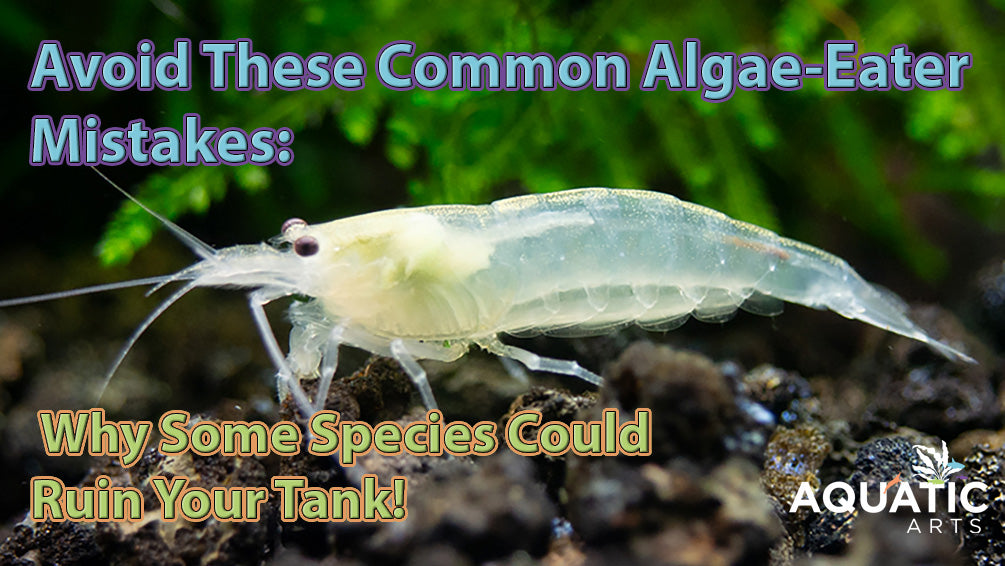Avoid These Common Algae-Eater Mistakes: Why Some Species Could Ruin Your Tank!

Not Every Algae Eater Fits Every Tank: Choosing the Right Combo for Your Aquarium
When it comes to maintaining a clean, algae-free aquarium, it’s tempting to grab the best algae eaters you can find and call it a day. But not all algae eaters are created equal, and some may not be suitable for your specific tank setup. To help you make the right choices, we’ve broken down why some of the options in our Pick Your Team; Algae Eating Crew – Customizable Aquarium Cleaning Combo might not fit every tank environment.
Choosing the Right Fish, Shrimp, and Snails for Your Setup
The beauty of a customizable algae-eating crew is that you can tailor the selection to fit your aquarium’s unique needs. However, it’s important to remember that not all species thrive in all types of tanks. Here’s a closer look at why some of these popular algae eaters might not work for every aquarium.
Panda Garra (Garra flavatra)

Why It Might Not Be Suitable:
Panda Garras are energetic swimmers that need plenty of room to roam. If you have a small tank (under 10 gallons), their active behavior can quickly overwhelm the space, and they may outcompete other, slower-moving fish. Additionally, they prefer moderate water flow and hard surfaces like rocks to graze on, which may not be ideal for tanks with soft substrates or delicate plants.
Not Recommended For: Small tanks, low-flow tanks, or tanks with delicate species.
Otocinclus Catfish (Otocinclus macrospilus)

Why It Might Not Be Suitable:
These peaceful little fish are highly sensitive to water quality, so they’re best suited to well-established tanks with stable parameters. If your tank is new or prone to fluctuating water conditions, Otocinclus may struggle. Their small size also makes them vulnerable to larger or more aggressive fish, so they’re best in peaceful community setups.
Not Recommended For: New tanks, tanks with large or aggressive fish, or unstable environments.
Siamese Algae Eater (Crossocheilus oblongus)

Why It Might Not Be Suitable:
Siamese Algae Eaters are robust and effective at tackling tough algae, but they grow large and need plenty of swimming space—ideally in tanks of 20 gallons or more. In smaller tanks, they may become territorial and aggressive, especially as they mature. Additionally, they prefer moderate to high water flow, which isn’t suitable for low-flow or planted tanks that thrive on gentle circulation.
Not Recommended For: Small tanks, low-flow setups, or tanks under 20 gallons.
Amano Shrimp (Caridina multidentata)

Why They Might Not Be Suitable:
Amano Shrimp are fantastic algae eaters, but they are vulnerable to aggressive tankmates. If your aquarium includes larger fish like Cichlids or Betta fish, there’s a chance the shrimp may become a snack. Additionally, they require stable water conditions, so they’re not a great fit for tanks where water parameters fluctuate frequently or where they may be outcompeted for food.
Not Recommended For: Tanks with predatory or aggressive fish, or unstable tanks with fluctuating water conditions.
Tiger Nerite Snail

Why It Might Not Be Suitable:
Nerite snails, including the Tiger Nerite, need stable water parameters and prefer hard water to keep their shells healthy. In tanks with soft or acidic water, their shells can deteriorate over time. Additionally, they can escape from tanks that aren’t securely covered, making them less ideal for open-top setups.
Not Recommended For: Soft or acidic water tanks, or open tanks where snails may escape.
Zebra Nerite Snail

Why It Might Not Be Suitable:
Zebra Nerites are excellent algae eaters, but like other Nerites, they cannot reproduce in freshwater, meaning they won’t contribute to the tank’s snail population. Additionally, they require hard water for shell health, so they may not be a good fit for soft water tanks. If you’re not keen on regularly cleaning up the white egg spots they leave behind, you might want to consider another species.
Not Recommended For: Soft water setups or tanks where visible egg spots are a concern.
King Koopa Nerite Snail

Why It Might Not Be Suitable:
Similar to other Nerites, King Koopa Nerites need calcium-rich water to prevent shell deterioration. They also have a tendency to climb out of tanks if there are any openings, which means you’ll need a tightly covered tank to prevent escapes.
Not Recommended For: Open-topped tanks or tanks with soft, low-calcium water.
Assorted Thorn Nerite Snail

Why It Might Not Be Suitable:
The thorny projections on their shells, while unique and visually striking, can make these snails prone to getting stuck in tight spaces or between decorations. Like other Nerites, they require hard water to maintain healthy shells and can leave egg spots on glass and décor that may not hatch but can be unsightly.
Not Recommended For: Tanks with heavy décor or soft water setups.
Pink Lady Nerite Snail

Why It Might Not Be Suitable:
The Pink Lady Nerite’s soft pink shell can degrade in soft water, much like other Nerites. These snails also need stable, calcium-rich environments to prevent shell erosion. If you’re looking for a snail that will breed in your tank, Pink Lady Nerites aren’t the right choice, as they cannot reproduce in freshwater.
Not Recommended For: Soft water setups or aquariums with insufficient calcium.
Key Considerations for Your Algae-Eating Team:
- Tank Size: Larger, active species like Panda Garras and Siamese Algae Eaters need more space to thrive. For nano tanks or smaller setups, consider Otocinclus Catfish and Amano Shrimp.
- Water Flow: Some species, like the Siamese Algae Eater, prefer moderate to high water flow. Be sure your tank’s flow matches their needs before adding them.
- Water Hardness: Nerite snails require hard water to keep their shells healthy. If you have soft or acidic water, they may not be the best choice.
- Compatibility: Make sure the species you choose can coexist peacefully. Amano Shrimp, for example, may not survive in tanks with aggressive or predatory fish.
- Water Stability: Sensitive species like Otocinclus and Amano Shrimp thrive in stable tanks with consistent water parameters. Avoid adding them to new or frequently changing environments.
Making the Right Choice for Your Aquarium
No matter what type of tank you have, there’s a perfect algae-eating crew for your setup. Whether you need a team for a nano tank, a planted aquascape, or a large community tank, these combos offer the best balance of functionality and aesthetics. Be sure to check out our article, 10 Best Algae-Eating Combos for Every Aquarium Setup, for detailed combo suggestions that match various tank needs. And remember, not every algae eater is suitable for every tank, so it's important to select the right species for your environment. Choose your ideal combo today and keep your aquarium clean and vibrant!




